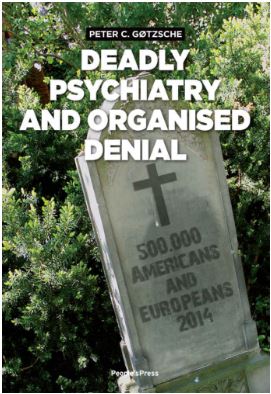 Deadly Psychiatry and Organised Denial by Peter C. Gotzsche
Deadly Psychiatry and Organised Denial by Peter C. Gotzsche
Reviewed by David Lorimer
Last April I reviewed Peter Gotzsche’s earlier book Deadly Medicines and Organised Crime, which was a systematic exposition of the corruption of the medical system through the pervasive influence of the pharmaceutical industry that effectively controls education, journals, regulation and governments, the last as a function of their obsession with economic growth. That book – which won the BMA ‘basis of medicine’ book prize in 2014 – contained a chapter on psychotropic drugs, which is the main topic of this new and equally hard-hitting book. As a reminder of the author’s credentials, he co-founded the Cochrane Collaboration in 1993 and established in the Nordic Cochrane Centre in Copenhagen as well as being professor in clinical research design and analysis at the University of Copenhagen. As a whistleblower, he has made himself extremely unpopular with the industry.
Two of the pillars of the conventional psychiatric approach using psychotropic drugs are the diagnostic categories in DSM-V and the biological approach that hypothesises that many mental disorders arise from chemical imbalances in the brain. Gotzsche argues that psychiatry has created a world full of erroneous ideas based on poor science and pseudoscience, ‘particularly in relation to the validity of diagnoses, the effects of diseases on the brain, and the effects of drugs on patients.’ He quotes the homepage of the American Psychiatric Association on depression that ‘antidepressants may be prescribed to correct imbalances in the levels of chemicals in the brain. These medications are not sedatives, uppers or tranquilizers. Neither are they habit-forming. Generally, antidepressant medications have no stimulating effect on those not experiencing depression.’ Gotzsche explains in detail that all these statements are wrong and yet they are an official pronouncement from the main psychiatric professional association in the US. This shows how deeply some of the myths have penetrated.
Contrary to this official view, it is the antipsychotic drugs themselves that cause brain damage, nor the so-called disease (p. 233). They lead to persistent personality changes with cognitive decline and emotional flatness long after patients have come off the drugs. Moreover, a 2012 survey by the Royal College of Psychiatrists about coming off antidepressants showed that 63% reported withdrawal symptoms, the most common of which was anxiety. This sometimes leads to a confusion between the withdrawal symptoms and a relapse, which is then used as justification for keeping the patient permanently on medication. The so-called disease is always to blame, not the pill. This leads to the startling conclusion that the apparent chronicity in mental disorders is in fact an artefact of the medications themselves (p. 246). Nearly 50% of Finns were still taking an SSRI five years after prescription while the median duration of an untreated depression is only three months (p. 257). The last 50 years of increasingly sophisticated treatments have in fact increased the burden of mental disorders, partly by creating new categories that did not exist before and by medicalising everyday human suffering (p. 299). There is also a large discrepancy between what psychiatrists and their patients think about their treatments. Most patients regard antidepressants and antipsychotics as more often harmful than beneficial and nearly 80% of one survey regarded antidepressants as addictive. Another important factor here is that the biological approach is associated with a mechanistic understanding of the human being, a view rejected by many enlightened practitioners and evidenced by the large membership of the spirituality and psychiatry special interest group at the Royal College of Psychiatrists.
The book covers a vast range of themes and conditions including depression, anxiety, ADHD, schizophrenia, bipolar disorder, dementia, electroshock, psychotherapy, drugs and the brain, withdrawal, corruption of people and science, and forced treatment. Besides analysis of clinical trials and research studies, the author also provides illustrative cases that add a human dimension to these tragedies. These make clear that in some instances sharp mood changes and even suicides are associated with SSRIs, and the main culprit is akathisia – the profession tends associate this with the disease when it is in fact clear that it is an effect of the drug (p. 92). The detail makes harrowing reading, not only for suicide but also for homicide.
So far as the organised denial of the title is concerned, it is easy to understand how trainees are initiated into a biochemical mindset and a series of assumptions (p. 14), all of which Gotzsche shows to be mistaken. They lead in turn to overdiagnosis and overtreatment, and categorisation can readily become a self-fulfilling prophecy. He characterises senior psychiatrists who are in the pocket of the industry as silverbacks suffering from collective, organised denial, of which the author gives many telling examples. More seriously, he shows how antipsychotics and antidepressants are responsible for an extra 500,000 deaths a year in the US and the EU (p. 310) – hence the deadly psychiatry of the title. So we have a situation whereby otherwise well-meaning physicians are complicit in a corrupt system that actually harms their patients. Gotzsche rather drastically advocates a reduction of our current usage of psychotropic drugs by 98% and the introduction of other proven therapies instead (p. 306). At the end of the book, he advises both patients and doctors on what they can do. As I said in my previous review, nothing short of a revolution is required in this field, and informed patients can undoubtedly play an important role. However, the financial interests involved are so enormous and their hold on the medical system so tight, that it is hard to see how this will change in the short term, although spiralling costs may shift government policy towards prevention. In any event, I would encourage both general readers and health professionals to read and reflect on the implications of this powerful evidence-based study. See also www.deadlymedicines.dk and www.bmj.com/content/350/bmj.h2435/rr-4 and a September 2015 conference on this topic – www.cepuk.org/moreharmthangood/ – can be accessed at https://www.youtube.com/channel/UC8eIK8kuf7tht1gV1HApH0g.
